

Featured Article of the Month
Friendship Across Borders and Cultures
By Ms Khartini Khalid
| A famous poet, William Butler Yeats, once said "There are no strangers here, only friends you haven’t met yet." This meaningful quote made me reflect on friendships and connections – how do they start, why do some continue while others do not, and how and why do they strengthen or fade over time. |
|
In pre-pandemic times, there were many opportunities to connect and make friends with people from abroad, including Japan. In the institution where I work, Ngee Ann Polytechnic, we used to have various opportunities to connect with Japanese people and universities through programmes like JENESYS (Japan-East Asia Network of Exchange for Students and Youths), a people-to-people exchange programme by the Japanese government for Japan and the Asia Pacific region. We also had our own outbound vacation module for Singapore students learning Japanese to visit Japan and practice their language skills. During the vacation, we would welcome Japanese students from different universities for inbound programmes as they visited Singapore and attended courses at our polytechnic to learn more about Singapore's society, economy and development.
One such university we have worked with is Nara Prefectural University (Nara PU). It all started with a JENESYS trip, where a group of 20 students and two of my colleagues from Ngee Ann visited Nara PU as one of the stops during their 10-day trip to Japan in 2015. A year later, during a study visit to Singapore, Nara PU's staff and students visited our polytechnic and we hosted them to a one-day programme which included learning about ethnic cultures in Singapore and participating in an Indian dance and a Malay dikir barat (group singing) demonstration. This was when I first met Professor Tetsuya Nakatani and Professor Hiroyuki Yakushiji from Nara PU, who, both being professors in the area of tourism studies, are globally attuned and interested in global and cultural issues and experiences. In subsequent years, (2017 and 2019) Nara PU students participated in a two-week course on Singapore Studies and Cross-Cultural Communication offered by our polytechnic. During the programme, Nara PU students would attend lessons on various aspects of Singapore's society, participate in various activities, and go for excursions to places of interest like Marina Bay Sands, Chinatown, Little India and Kampong Gelam. They would be accompanied by Singapore students who would become their 'buddy' during their time here, and hopefully friends after that. The Singapore students would often take the Japanese students to other places after class, recommend food and drinks to try, and share information about their lives as students and youths in Singapore. | 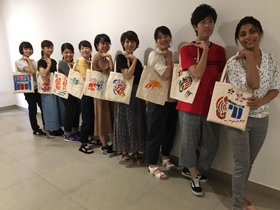 Students and Professor Nirmala Ranasinghe from Nara PU showing their creative tote bag prints which they produced in a workshop conducted at Ngee Ann Polytechnic. (Taken in 2019) 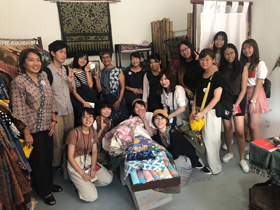 During a visit to Kampong Gelam, students stopped by Kiah’s Gallery, a small batik showroom and shop that customizes batik creations. (Taken in 2019) 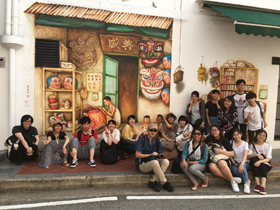 Taking a quick breather in front of a mural in Chinatown during a tour of the area. (Taken in 2019) |
|
The COVID-19 pandemic threw a spanner in the works for such programmes as global travel came to a halt in early 2020. With our daily lives being upended both at home and at work, the initial stages of the pandemic saw most people focusing on living with a "new normal", trying to get used to new ways of doing things such as working from home, attending classes online, and just staying safe and being in good health.
As the pandemic wore on, I started to miss having contact from abroad. Living in a small country like Singapore and having travel restrictions in place was especially tough with limited spaces and places to explore and no real countryside to escape to. |
|
Together with my colleague Yoko Hirata, we reached out to Nara PU and offered to do an online webinar on Singapore titled "Diversity as a Strength" for their staff and students. The webinar was held in March 2021 and despite it being their vacation period, a total of 40 students and staff of Nara PU attended the webinar. It felt good interacting with people from abroad even if it was via Zoom. Sometime later that year, I received, to my surprise, an email from Nara PU offering an online tour of Nara to be conducted by their students for our students and staff. For around 40 minutes, a group of 60 students and staff of Ngee Ann "travelled" through the streets of Naramachi and Nara Park in real time, and we caught some glimpses of Nara deer and autumn leaves. It was not easy to plan and execute a live virtual tour on a weekend but the Nara PU students put up an admirable effort in doing so. After the tour, they even hurriedly caught a taxi back to campus and conducted an online interaction session for our students.
This brings me back to my first point in this article - how do friendships and connections start? Why do some continue while others do not? How and why do they either strengthen or fade over time? |
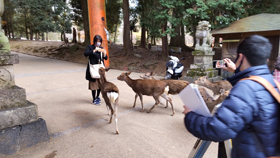 The appearance of the famous Nara deer during the live online tour in Nara Park brought delight to the audience in Singapore. 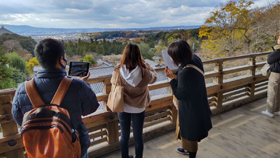 The beautiful scenery offered the audience a glimpse of the changing autumn leaves in Nara. |
| Programmes like JENESYS offer an excellent starting point to connect people who otherwise would have been strangers. Beyond that, it is up to people to continue nurturing their ties with one another. At times, it could be through paid programmes that are offered by one party to another. At other times, it could be through exchanges such as a simple webinar or a live online tour which leaves the feeling of 'kimochi ii' 気持ちいい(feelings of goodness) between both parties. The pandemic has changed many things in life but one thing it cannot do is to stop the will of people to promote 'kizuna' or bonds and connections of friendship with one another. |
About the Author
|
Ms Khartini Khalid is a Senior Lecturer/ Manager with the School of Interdisciplinary Studies, Ngee Ann Polytechnic, where she teaches modules on global issues and interdisciplinary project work. On a personal level, Khartini has a deep interest in Japanese culture and society. Before the pandemic, she would travel to the countryside in Japan at least once a year, staying at ryokans and visiting onsen towns in remote areas. She misses Japan tremendously and continues to explore many different ways to connect emotionally and virtually with Japan while waiting for travel between both countries to resume. * All photos used in this article are provided by Hiroyuki Yakushiji, Khartini Khalid and Juliet Tan. |
|
Japan Creative Centre 4 Nassim Road, Singapore 258372 +65 6737 0434 / jcc@sn.mofa.go.jp https://www.sg.emb-japan.go.jp/JCC/ Nearest parking at Orchard Hotel & Delphi Orchard |
 |